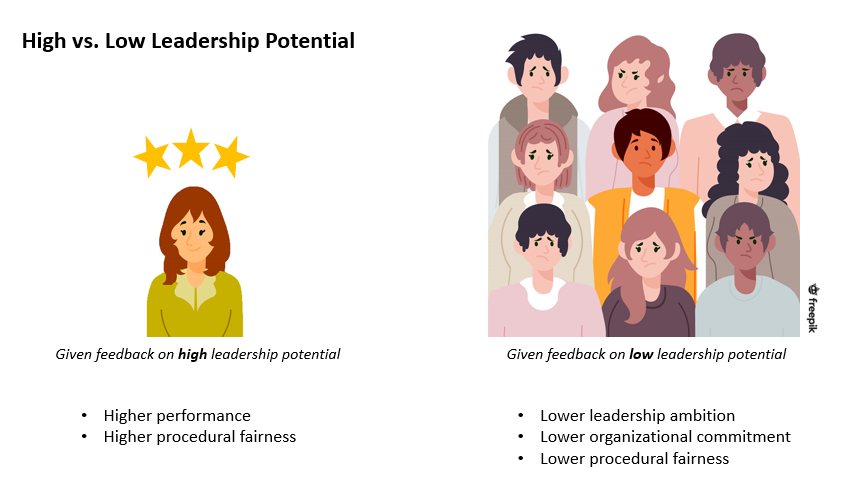Digest 28. Feedback to non-talents: Happy rising stars vs. unhappy crowd
Succession planning and the development of future leaders is one of the top concerns of organizations, as found by a Deloitte survey (see it at this link). About 38% of organizations referred this as one of their three most pressing needs together with globally competing for talents and retaining them. In terms of succession planning, organizations normally try to identify their talents early on, spotting those who have potential for leadership. To this aim, they use various evaluations so that they can further invest on their talents through targeted and often exclusive training and development opportunities and prepare them for future leadership roles. The talent evaluations –back in the days also known as potential assessment- normally consist of appraising a certain number of candidates and selecting few from those, since the number of leadership roles are limited – even more in contemporary workplaces, which are becoming flatter and flatter. Consequently, the majority of employees will, in fact, be excluded from leadership succession programs after the evaluation phase and this may have the paradoxical effect of demotivating them in comparison to the few chosen ones.
What are the effects of feedback on the lack of leadership potential?
Steffens and colleagues (2018) conducted two studies on this topic. In the first study, 256 participants were recruited via an online platform and asked to imagine working in a workplace where the position of team leader was to be filled; in this fictitious scenario, everyone was told to apply, and all applicants received positive feedback about their current performance. These participants were then randomly assigned to one of three experimental conditions: 1) one group received feedback saying they had low leadership potential, 2) another group received feedback saying they had high leadership potential; and 3) the control group received no information on their leadership potential. The analyses showed that those who were in the first condition reported afterwards lower leadership ambition and lower organizational commitment in comparison to the other two groups.
In the second study, 264 undergraduate students participated in a computerized experiment with multiple stages. At every stage, each participant was informed about their own performance and not about the others’. At stage 1, participants were given numerous arithmetic operations to solve in two minutes. At stage 2, they had to repeat the same task but in random groups of 3 participants and they were compensated for their performance. At stage 3, they had to do a word completion task individually. At stage 4, which required participants to complete once more a task similar to the previous ones, the leadership potential was manipulated. Participants were informed that two of them would be chosen as leaders and the chosen ones had to distribute a bonus between team members. Accordingly, high vs. low leadership potential feedback was randomly given to each member. Two members in each team received the “high leadership potential” label and two the “low leadership potential” label. In the control group, no leadership potential feedback were given and members were told that leadership appointment would be done randomly by the computer. The analyses of this study showed that those who received low leadership potential feedback perceived lower procedural fairness and had lower performance in comparison to those who received high leadership potential feedback.
The two studies together show that providing feedback on leadership potential impacts employees’ ambition to become leaders, their commitment and performance and that this differently occurs for those that receive positive feedback (i.e., high potential) and those that receive negative feedback (i.e., low potential).
Organizational implications
These findings have multiple implications for organizations and professionals who are responsible for talent management programs:
Since programs such as talent management may result in non-selected individuals to become less motivated and enthusiastic for what they do, organizations should avoid invasive succession processes by focusing less on competitive distinctiveness between individuals. In fact, we already know that using social comparison when evaluating performance can be a boomerang (see Digest 14).
Conversely, and to avoid the double-edged effects of “elitist” talent management programs, organizations may focus on more inclusive approaches, which emphasize the organization’s commitment to nourish (and not to sideline) individuals' capacity to grow into leaders. See on this additional literature.
The findings also suggest that succession planning efforts may not be fully independent from efforts in retention. Hence, organizations could offer individuals multiple career trajectories with leadership roles (requiring leadership potential assessment) being only one of them. In this way, those individuals excluded from leadership development initiatives, may continue within different but just as structured developmental and career paths.
——
Reference: Steffens, N. K., Fonseca, M. A., Ryan, M. K., Rink, F. A., Stoker, J. I., et al. 2018. How feedback about leadership potential impacts ambition, organizational commitment, and performance. The Leadership Quarterly, 29(6): 637–647. https://doi.org/10.1016/j.leaqua.2018.06.001

